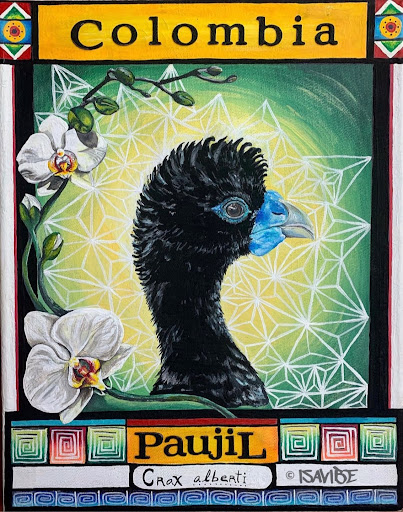
Women for Conservation and ProAves have worked since 2004 to protect the Critically Endangered Blue-billed Curassow and its unique habitat by raising awareness and empowering local women’s groups to save this spectacular species.
Location: Magdalena Valley, Colombia
Key Species: Blue-billed Curassow (CR), Magdalena Spider Monkey (CR), Magdalena Lowland Tapir (VU), Spectacled Bear (VU), Jaguar (NT)

Habitat: Tropical lowland rain forest
Primary Threats: Hunting of the curassow and collection of its eggs; habitat loss from logging, cattle ranching, and coca plantations.
Conservation Actions: Establishment of participatory community agreements to prevent hunting; Creation of a tree nursery for reforestation with native plant species; introduction of fuel-efficient cook stoves and training in sustainable production of jewelry from Tagua seeds to prevent deforestation; provision of access to voluntary family planning and health clinics.
Since 2004, Women for Conservation has collaborated with rural Colombian communities living around ProAves nature reserves to protect endangered species and their habitats. By offering workshops that raise awareness about threats to local wildlife, we empower women and children with conservation education and then help them to develop projects and sustainable livelihoods that preserve nature and prevent species extinction.

In the community of Puerto Pinzón in the lowland rain forests of central Colombia’s Magdalena Valley, the ecosystems of the Amazon and Chocó converge to produce astonishing levels of biodiversity. As a result, the area harbors extraordinary endemism (species found nowhere else on Earth), like the Blue-billed Curassow (Crax alberti). A turkey-sized bird with a blue-colored bill and curly black feathers on its head resembling a mohawk, the Blue-billed Curassow is ranked as Critically Endangered by the IUCN. As a result of rampant deforestation primarily for logging, cattle ranching, and coca plantations, nearly 98% of the bird’s habitat has been destroyed. With its range shrunken dramatically, the curassow now is mostly concentrated within a single site. In addition, hunting of the bird and collection of its eggs for food has devastated the species, making it exceedingly rare.

To help save the Blue-billed Curassow from extinction, Women for Conservation and Colombian partner Fundación ProAves concentrated on raising awareness about the species among the local community. W4C hosted several conservation workshops, encouraging women and children to protect the curassow. Subsequently, a number of conservation activities were initiated to save the species. For instance, local residents entered into a participatory agreement in which they committed to end hunting of the curassow and to find an alternative food source. Furthermore, to protect the species’ habitat, fuel-efficient stoves were introduced that prevented deforestation by reducing the amount of wood being burnt. In addition, habitat was protected by teaching women sustainable livelihoods, such as collecting tagua nuts from the forest that could be used to produce elegant jewelry and artisan crafts for sale, helping to replace their dependence on cattle ranching and other environmentally destructive practices. Finally, a tree nursery with native species was established by the women’s group as a model for the community and was used to teach the importance of reforestation and how to successfully cultivate these species.

With great thanks to our conservation program with our local Colombian partners, today the Blue-billed Curassow is recognized and respected as an emblem of the natural heritage of the community. In fact, the curassow is even celebrated in an annual festival. Now that a safe haven has been created for this unique bird, there has been a significant increase in its sightings and group sizes in the area, signifying that the population is rebounding locally. Click here to read about our other initiatives to protect the Blue-billed Currassow and the Cotton-Top Tamarin.

